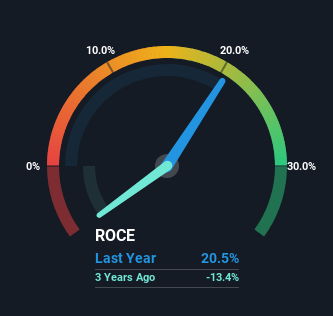- United Kingdom
- /
- Hospitality
- /
- LSE:TRN
The Trend Of High Returns At Trainline (LON:TRN) Has Us Very Interested
What trends should we look for it we want to identify stocks that can multiply in value over the long term? Amongst other things, we'll want to see two things; firstly, a growing return on capital employed (ROCE) and secondly, an expansion in the company's amount of capital employed. This shows us that it's a compounding machine, able to continually reinvest its earnings back into the business and generate higher returns. With that in mind, the ROCE of Trainline (LON:TRN) looks great, so lets see what the trend can tell us.
What Is Return On Capital Employed (ROCE)?
For those who don't know, ROCE is a measure of a company's yearly pre-tax profit (its return), relative to the capital employed in the business. The formula for this calculation on Trainline is:
Return on Capital Employed = Earnings Before Interest and Tax (EBIT) ÷ (Total Assets - Current Liabilities)
0.21 = UK£91m ÷ (UK£719m - UK£276m) (Based on the trailing twelve months to August 2024).
Thus, Trainline has an ROCE of 21%. That's a fantastic return and not only that, it outpaces the average of 7.7% earned by companies in a similar industry.
View our latest analysis for Trainline

In the above chart we have measured Trainline's prior ROCE against its prior performance, but the future is arguably more important. If you'd like to see what analysts are forecasting going forward, you should check out our free analyst report for Trainline .
How Are Returns Trending?
You'd find it hard not to be impressed with the ROCE trend at Trainline. The data shows that returns on capital have increased by 4,819% over the trailing five years. The company is now earning UK£0.2 per dollar of capital employed. Interestingly, the business may be becoming more efficient because it's applying 24% less capital than it was five years ago. Trainline may be selling some assets so it's worth investigating if the business has plans for future investments to increase returns further still.
On a side note, we noticed that the improvement in ROCE appears to be partly fueled by an increase in current liabilities. Essentially the business now has suppliers or short-term creditors funding about 38% of its operations, which isn't ideal. Keep an eye out for future increases because when the ratio of current liabilities to total assets gets particularly high, this can introduce some new risks for the business.
The Key Takeaway
In a nutshell, we're pleased to see that Trainline has been able to generate higher returns from less capital. Given the stock has declined 14% in the last five years, this could be a good investment if the valuation and other metrics are also appealing. That being the case, research into the company's current valuation metrics and future prospects seems fitting.
While Trainline looks impressive, no company is worth an infinite price. The intrinsic value infographic for TRN helps visualize whether it is currently trading for a fair price.
If you want to search for more stocks that have been earning high returns, check out this free list of stocks with solid balance sheets that are also earning high returns on equity.
Valuation is complex, but we're here to simplify it.
Discover if Trainline might be undervalued or overvalued with our detailed analysis, featuring fair value estimates, potential risks, dividends, insider trades, and its financial condition.
Access Free AnalysisHave feedback on this article? Concerned about the content? Get in touch with us directly. Alternatively, email editorial-team (at) simplywallst.com.
This article by Simply Wall St is general in nature. We provide commentary based on historical data and analyst forecasts only using an unbiased methodology and our articles are not intended to be financial advice. It does not constitute a recommendation to buy or sell any stock, and does not take account of your objectives, or your financial situation. We aim to bring you long-term focused analysis driven by fundamental data. Note that our analysis may not factor in the latest price-sensitive company announcements or qualitative material. Simply Wall St has no position in any stocks mentioned.
About LSE:TRN
Trainline
Engages in the operation of an independent rail and coach travel platform that sells rail and coach tickets worldwide.
Undervalued with solid track record.
Market Insights
Community Narratives



